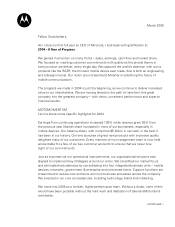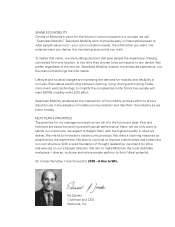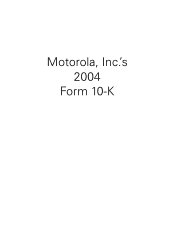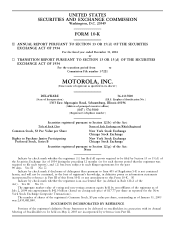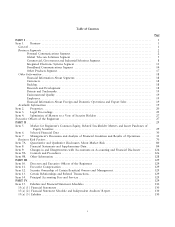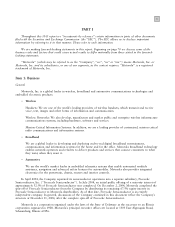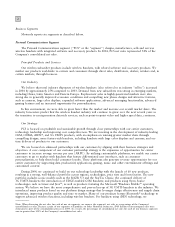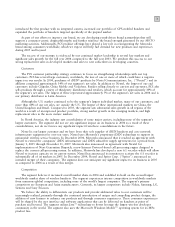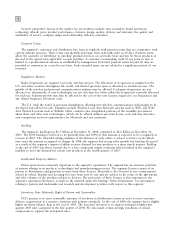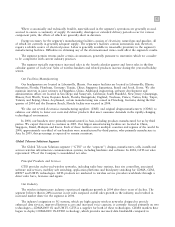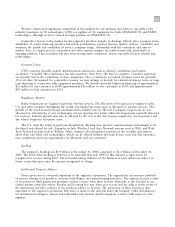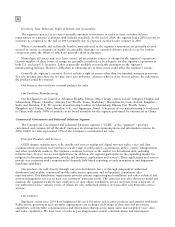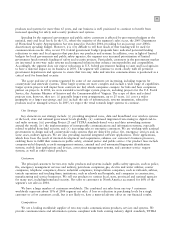Motorola 2004 Annual Report Download - page 10
Download and view the complete annual report
Please find page 10 of the 2004 Motorola annual report below. You can navigate through the pages in the report by either clicking on the pages listed below, or by using the keyword search tool below to find specific information within the annual report.
2
Business Segments
Motorola reports six segments as described below.
Personal Communications Segment
The Personal Communications segment (""PCS'' or the ""segment'') designs, manufactures, sells and services
wireless handsets with integrated software and accessory products. In 2004, PCS net sales represented 54% of the
Company's consolidated net sales.
Principal Products and Services
Our wireless subscriber products include wireless handsets, with related software and accessory products. We
market our products worldwide to carriers and consumers through direct sales, distributors, dealers, retailers and, in
certain markets, through licensees.
Our Industry
We believe that total industry shipments of wireless handsets (also referred to as industry ""sell-in'') increased
in 2004 by approximately 25% compared to 2003. Demand from new subscribers was strong in emerging markets,
including China, Latin America and Eastern Europe. Replacement sales in highly-penetrated markets were also
strong due to generally improved economic conditions and compelling new phone designs and attractive features,
such as cameras, large color displays, expanded software applications, advanced messaging functionality, advanced
gaming features and an increased opportunity for personalization.
In this environment, we were able to grow faster than the market and increase our overall market share. The
industry forecasters predict that the wireless handset industry will continue to grow over the next several years as
the transition to next-generation data-rich services, such as point-to-point video and higher speed data, continues.
Our Strategy
PCS is focused on proÑtable and sustainable growth through close partnerships with our carrier customers,
technology leadership and improving cost competitiveness. We are investing in the development of industry-leading
GSM, CDMA, iDEN», and 3G UMTS products, with an emphasis on winning greater market share through
compelling designs, more feature-rich handsets, including handsets with large color displays and cameras, and on-
time delivery of products to our customers.
We are focused on enhanced partnerships with our customers by aligning with their business strategies and
objectives. A core component of our customer partnership strategy is the expansion of opportunities for carrier
customers to increase average revenue per user (ARPU). By utilizing customizable platforms, we enable our carrier
customers to go to market with handsets that feature diÅerentiated user interfaces, such as consumer
personalization, to help them build consumer loyalty. These platforms also generate revenue opportunities for our
carrier customers by supporting data productivity applications, gaming, music and other entertainment oÅerings and
customized content.
During 2004, we continued to build on our technology leadership with the launch of 60 new products,
resulting in a strong, well-balanced portfolio across regions, technologies, price tiers and form factors. The new
portfolio includes iconic models such as the RAZR V3 and the StarTac Classic; the continued delivery of
3G UMTS handsets; the introduction of EDGE-enabled GSM handsets; and products using Open Source
technologies such as Linux and Javatm, as well as products featuring the Microsoft Windows Mobiletm operating
system. We believe we have the most comprehensive and proven line-up of 3G UMTS handsets in the industry. We
introduced many products based on our platform design strategy that leverages design eÅectiveness and supply chain
operations, improving product quality and time to market. Many of our products feature Bluetooth» technology to
support advanced wireless functions, including wireless headsets. For handsets using iDEN technology, we
Note: When discussing the net sales for each of our six segments, we express the segment's net sales as a percentage of the Company's
consolidated net sales. Because certain of our segments sell products to other Motorola businesses, $963 million of intracompany sales were
eliminated as part of the consolidation process in 2004. As a result, the percentages of consolidated net sales for each of our business segments
sum to greater than 100% of the Company's consolidated net sales.



